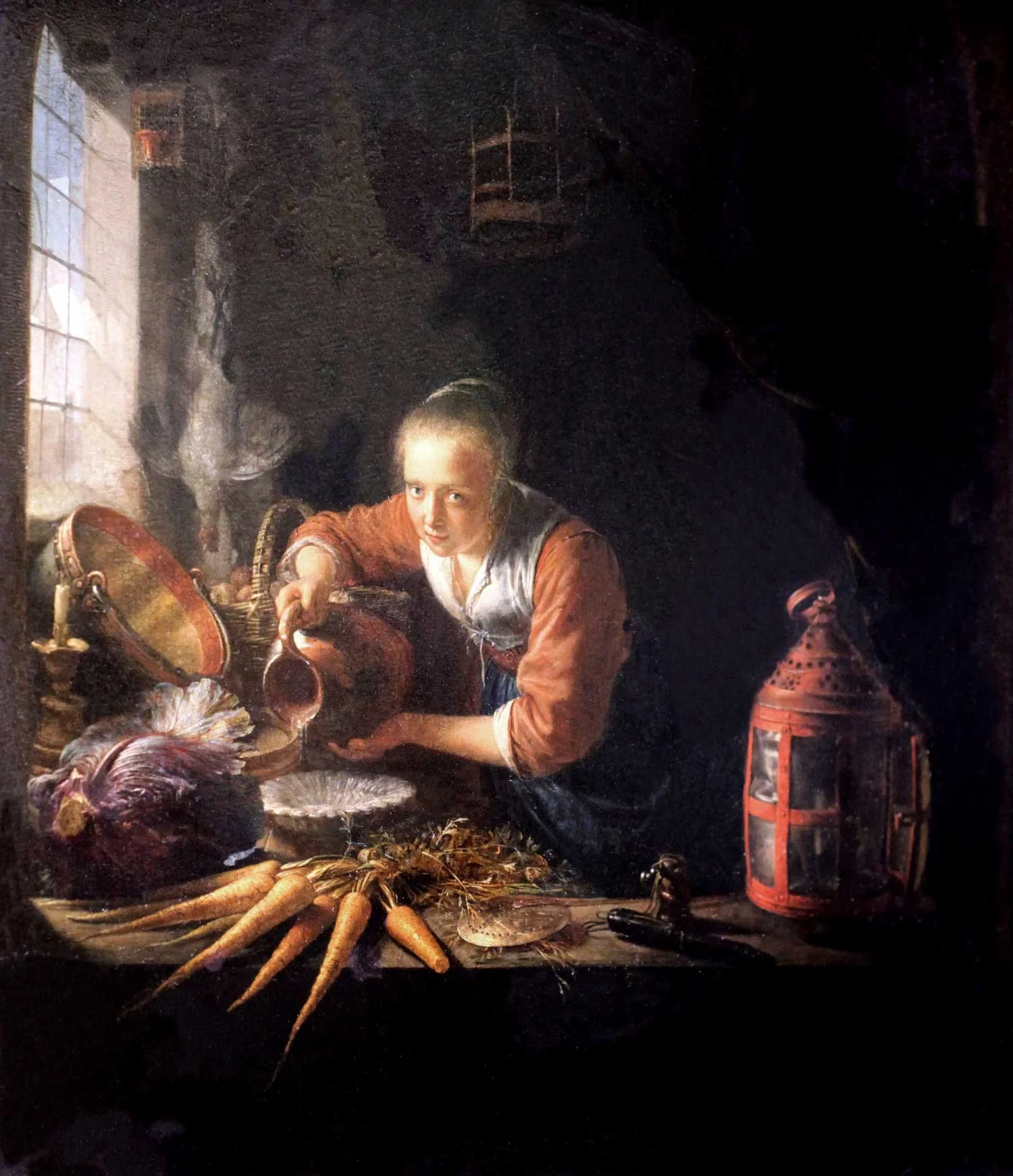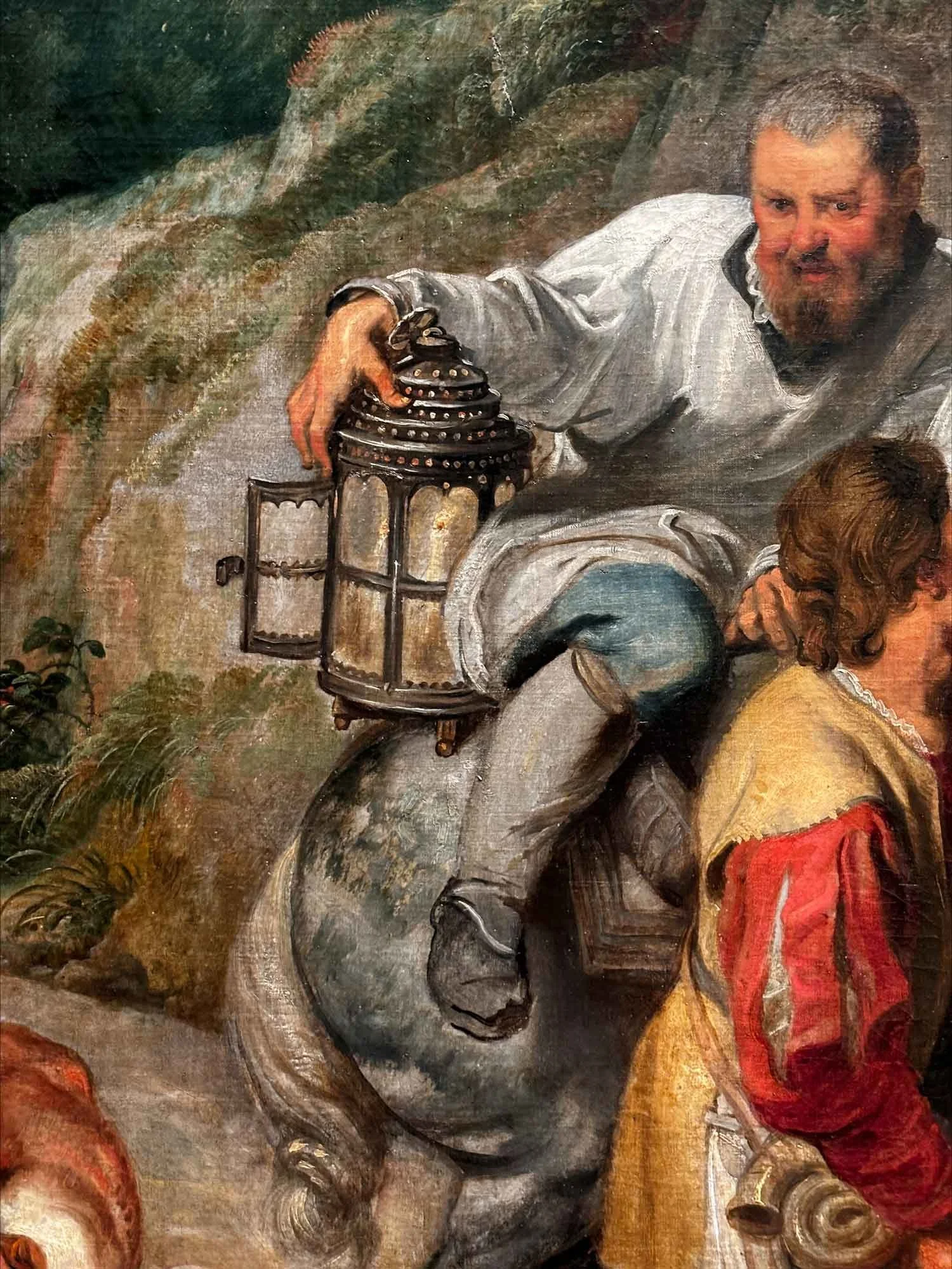I found more information about large lanterns.
I enjoy studying and recreating traditional tin lanterns, drawing inspiration from sources such as paintings, books, drawings, and museum collections. There is always something new to learn and try. But gathering information on the history of tin lanterns is frustrating. Many of the books written about tinware feature great images but are less helpful when terms like "antique," "Early-American," "early," and "primitive" are often used to describe when somebody made the lantern. "Late 18th or early 19th century" is not a particularly helpful term. In addition, the references and documentation for most of the available sources are woeful at best.
Often, I come across a lantern in a period drawing or painting that I find interesting and would like to attempt to duplicate. It could have a different shape or an unusual top shape. Sometimes, the lantern is very elaborate, with lots of cutouts and decorative elements. At other times, it's just a solid, practical lantern that living history enthusiasts would like to have to make their impressions more authentic and unique. My Guardroom Lantern is one of the lanterns that was inspired by a period painting.
The first image I found of this sort of large hanging lantern is from "Guardroom with the Deliverance of St. Peter, 1645-47, painted by the Flemish artist David Teniers the Younger. The painting is in the collection of the Metropolitan Museum of Art, object #64.65.5. This is a detail from the painting. Notice how large this lantern is. I especially like the punched tin patterns and the use of beading throughout the lantern. The lantern appears to have a wooden cross-shaped base of some sort.
A second painting that I have recently become aware of is "Woman pouring water from a jug" by Gerrit Dou, circa 1645-55. The painting shows a similar lantern painted red. The original is in the Louvre in Paris. I like how the artist painted the horn panes warped from the heat. On a side note, take a look at the hanging lantern in the shadows overhead. It appears to have an open bottom.
Klara from the Rubens House Museum sent me a link to this interesting image. The painting is "Act of Devotion of Rudolf 1 of Hasburg", by Peter Paul Rubens, around 1625. The original is in the Prado Museum in Madrid, Spain, catalog #P001645. The lantern in the painting is similar in size and scale to the other lanterns mentioned, with a wedding cake-like top. But notice the wooden cross with ball feet on the bottom.
These three images, all painted within a few years of each other, reinforce my theory that there were numerous variations in lantern designs available throughout the years. It reminds me of two competing philosophies in the living history world. On the purist side of the hobby, there is a rule that if you can't find three references to something in primary sources, then it can't be used. The alternative theory is that if the tools, techniques, and similar designs had existed, then it could have been possible. It's the "the absence of evidence is not evidence of absence" theory. And let's not forget the comic response, "If it's brown, it's good enough." I try to stay reasonably close to an original example. But I also fully believe that if someone walked up to a lantern maker and said, "I'd like 10 of these but 2" taller," the lanterns got made 2" taller.
I think of the term ship lantern; we use that one a lot. We all know the reproduced lanterns that hang on the HMS Victory. I make a version of it myself. Did it start as a "ship lantern," or did a captain walk in and say I need 100 lanterns for my ship? What do you have? Who knows. I do not believe that I have seen, nor have I found, any documentation to support the idea that all ship lanterns were the same for a given period.
Anyway, back to the Guardroom lantern. I have made several variations on the theme, all based on the same basic dimensions. For the past week or two, I have been trying to understand the wooden cross bracing. For example, were they just nailed to the solid bottom of a lantern to keep it out of the mud? Or was the bottom of the lantern left off so that the candlelight could shine out the bottom? In the second case, were the crosses inset into the bottom, with candle cups on the top of the cross, or were the candle cups suspended in some way inside? Shelley wonders if the cross could be lowered separately to allow easy candle changing. I don't know. The artists did not anticipate my curiosity at the time.
Speaking of design details. Have you ever noticed that on the old lantern, the horizontal glass guards are not spaced evenly from bottom to top? Generally, the top gap is smaller than the bottom. Ever wonder why? I have. I know, sad. But, if you are cranking out a mess of lanterns with a horizontal divider, you can do two things. First, you can measure each lantern and account for any variations in the opening size, then math out the exact center of each lantern. This takes a long time at the bench. Alternatively, you can create a spacer block that positions the divider slightly above the center intentionally. This way, it looks like you meant to make the top smaller, and a bit of variation on the size of the top opening from lantern to lantern does not matter. This is easier and much faster to make. Those makers were not dumb. Time is money.
Anyway, I am finishing up a batch of Guardroom Lanterns that should be available on the website by the time this posts. Head over to my website store and take a look.



